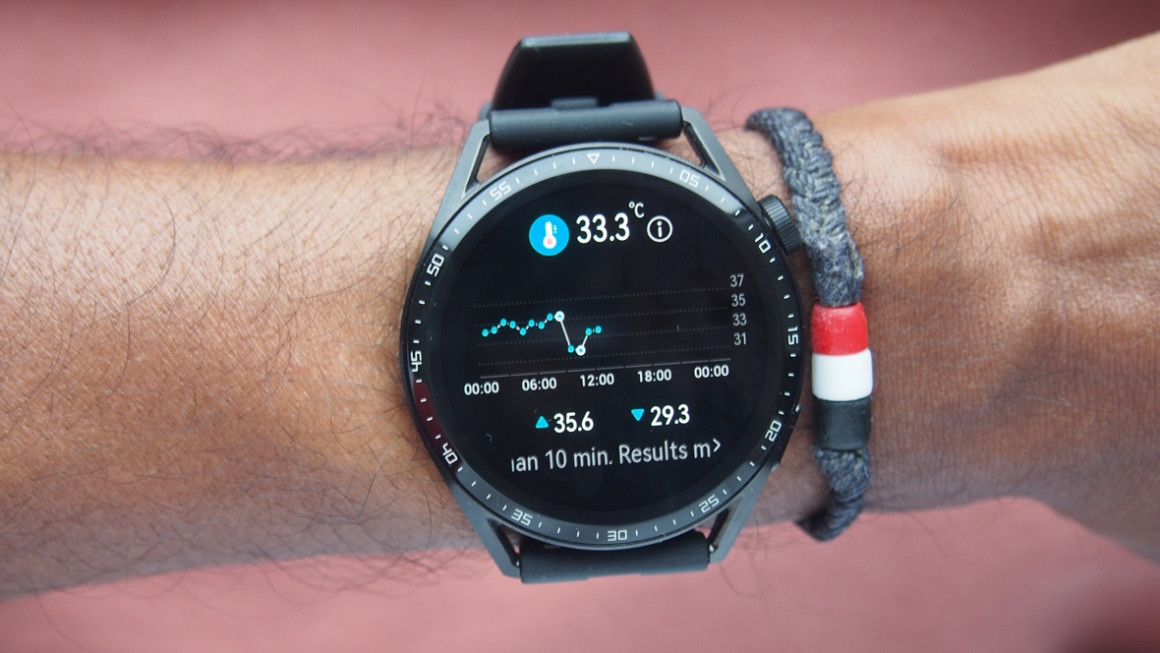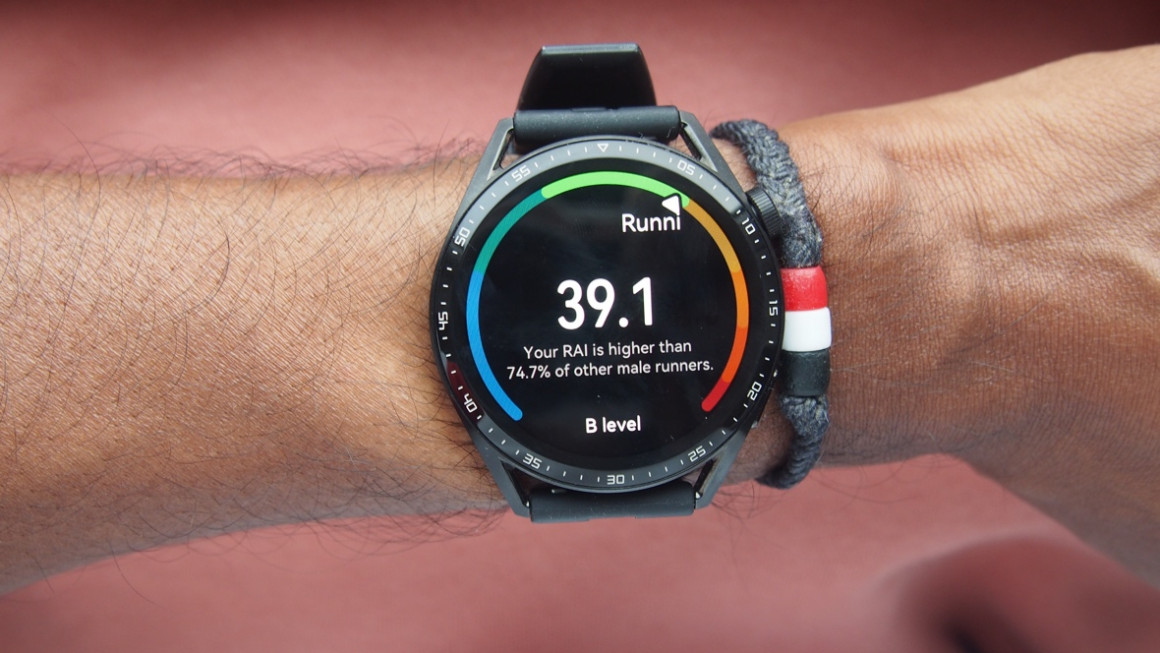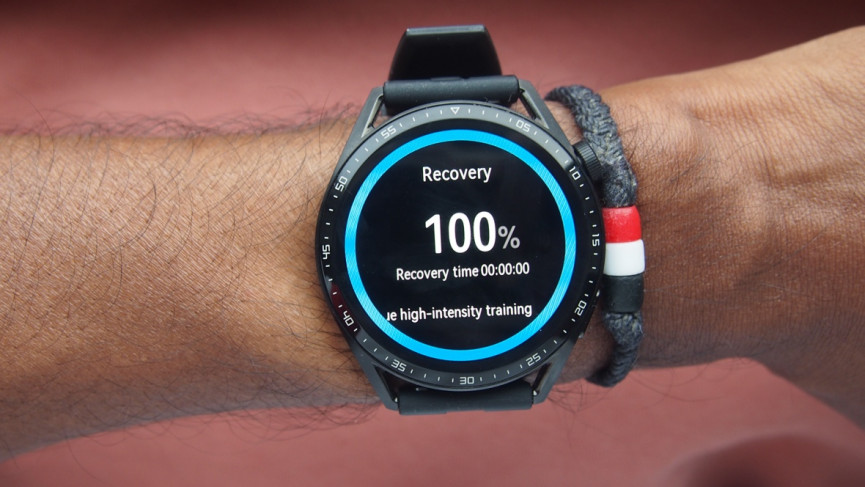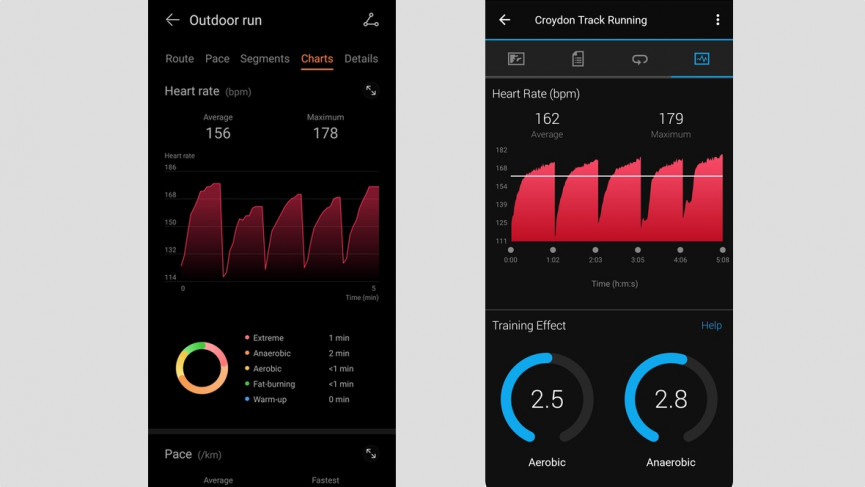
- Nice look, comfortable to wear 24/7
- Solid sports tracking
- Week's worth of battery life
- Not the best smartwatch features
- Lack of third party apps in app store
- Iffy sleep tracking
The Huawei Watch GT3 is the follow-up to the GT2, the company's flagship until the launch of the Huawei Watch 3.
The GT3 comes cheaper than the Watch 3 but shares a lot of the same features.
That includes Huawei's Harmony OS operating system and access to its AppGallery app storefront.
There are also new fitness features, an improved heart rate monitor, and new features targeting runners, including a new AI coach and personalized training plans. That's on top of offering everything we got on the Watch GT 2 and its many spin-offs including weeks as opposed to days of battery life.
So how does it stack up? Read our full testing to find out – and if you're a runner, make sure you read our Huawei Watch GT Runner review.
- Read our full Huawei Watch GT3 Pro review
Huawei Watch GT 3 key features
- 42mm and 46mm sizes
- Runs on Harmony OS
- Works with Android and iOS
- Huawei TrueSeen 5.0 heart rate sensor
- Dual-Band GNSS positioning for outdoor tracking
- 100+ workout modes
- AI running coach
- Up to 2 weeks of battery life
- 5ATM waterproof rating
Quick verdict and alternatives
We prefer the Huawei Watch GT3 to the more premium and advanced Huawei Watch 3, and it's a good option for Android and iOS users looking for a sporty smartwatch – especially runners.
However, it's not the best for either subset of users.
At this £229.99/$300 price point, we'd certainly push iOS users to the Apple Watch SE – which we feels offers a much better all-around smartwatch experience.
And Android users are now spoiled for choice with the Samsung Galaxy Watch 4, which leverages Wear OS's app selection to be a great value, premium smartwatch.
But there's a lot to like about this Huawei Watch GT3.
- Read our best smartwatch guide.
Design and screen
Wareable
Huawei hasn't made radical changes to the overall look of the GT3 when you see how it compares to the GT2.
There are refinements and brought-in elements from the Huawei Watch 3, and the result is something that's still sleek, good-looking, and geared toward men. However, there is a smaller, unisex size.
It comes in 46mm and a smaller 42mm round case size, with the former measuring 11mm thick and the latter the slimmer at 10.2mm thick. That case is made from stainless steel up front and plastic around the back, and the larger 46mm version we had to test weighed in at just over 42g (without a strap). We'd say it's a nicely weighted watch to wear that doesn't feel too chunky and that 46mm case didn't sit too big on our slender wrists either.
In the strap department, you've got a pick of fluoroelastomer, leather, or a steel strap with some different colors on offer for the two case sizes.
We had the black fluoroelastomer one, which uses a traditional watch buckle and felt comfortable to wear day and night and didn't cause any sort of irritation.
Wareable
On the case, you've got two physical buttons with the one further up the case now modeled on a watch crown, which was a key design feature introduced on the Huawei Watch 3.
That means you can twist it to scroll through screens and zoom in and out of apps like maps. The bottom button is assigned to get you quick access to the workout tracking screen, but you can still customize it to be a shortcut to another feature you regularly use.
That's partnered up with a 1.43-inch, 466x466 resolution AMOLED touchscreen display with a smaller 1.39-inch AMOLED packed onto the 42mm GT3. That means a slight bump up in resolution, but ultimately it's another really lovely display to use. It's nice and responsive to swipes and taps, offers sharp, accurate colors, and rich blacks and visibility is strong indoors and outdoors.
We didn't have to use it anywhere near the maximum brightness setting day-to-day and there's the option of an always-on display mode, which offers a plain black-and-white screen to show off the time when you're not interacting with the screen.
Huawei is sticking to the same waterproof rating as the GT2, so you're getting something that's 5ATM water resistant, letting you dunk it in water up to 50 meters depth. We've been swimming and jumped in the shower with it, and can confirm it's survived without issue.
As we said, there aren't wholesale changes made by Huawei here and that's not necessarily a bad thing. The Huawei Watch 3 feels more classic watch in terms of look, while the GT3 feels stylish but with a slightly more sports watch edge to it.
HarmonyOS and smartwatch features
Wareable
Now the GT3 runs on the same HarmonyOS operating system as the Huawei Watch 3.
What that HarmonyOS brings is software that's a bit more fully formed than LiteOS in terms of its capabilities as a smartwatch. It brings the new-look app grid, some slicker-looking user interface animations, and crucially, an app store.
Wareable
The Huawei AppGallery is currently only available through the Huawei Health companion phone app and it's fair to say that while it has the capability of offering third-party apps, it's not exactly brimming with them yet.
It's largely the same apps we found there when testing the Huawei Watch 3 and we downloaded ones like the FotMob football scores app and Fitify Workouts app, but if you're expecting to find Strava, Uber, and other big-name apps here, that just isn't the case right now.
Wareable
Outside of the HarmonyOS extras, a lot of what we saw on the GT2 as far as using it as a smartwatch remains the same. It does work with Android and iOS devices, but the former will get the most complete experience including access to the built-in music player.
Notification support works well enough, with small icons used to determine where the notification has come from and you can tap to expand them as well. Once again though, you can't respond to notifications.
Features like weather forecasts and music controls and the ability to handle calls (via Bluetooth) are well implemented and you've got simple features like a flashlight and the ability to set alarms and multiple timers, which aren't groundbreaking features but worked without issue.
There's a nice array of digital and analog-style watches and if you want more, there's more to be found in the Huawei Health app. You'll just have to be willing to pay up for them though.
Wareable
There's Huawei's Celia smart voice assistant, which can handle simple commands setting up timers, alarms, and checking the weather, but certainly doesn't feel as evolved as Apple's Siri, Google's Assistant, or using Amazon Alexa on smartwatches that currently pack it like the Fitbit Versa 3.
If you're looking for something with LTE, you're going to have to grab the Huawei Watch 3 for that, which seems to be one of the biggest differences between the two watches. You're also not getting any kind of payment support here, which is a bit of a shame.
The GT3 certainly doesn't give you the best smartwatch experience, it gives you one that's just good enough. A lot will rest on what happens with that app store, which right now, doesn't look great and have a lot in it. If some big names can be added, then it would be a major boost for HarmonyOS and the GT3.
Health and fitness tracking
Wareable
Where Huawei has impressed with its GT watches is how they perform when it comes to keeping tabs on your fitness. You'll find no regulatory-approved medical features that will tell you whether you have atrial fibrillation or sleep apnea, but it does offer plenty if you like to track your exercise. Particularly if you're a runner.
We'll start with general fitness tracking first though, where you're getting a ring-style widget to keep track of daily steps, exercise time, and stand time. You'll also be fired over inactivity alerts reminding you to move during the day.
Huawei has added a new Healthy Living clover, which looks beyond things like steps and will remind you to drink water, get up at a good time and even smile more. You'll need to get this set up in the Huawei Health app first and then you can check in your clover is glowing to show you're hitting those lifestyle targets.
Wareable
It's good that Huawei has sought to think more about tracking things outside of the usual metrics, and while it's essentially a prettier way to represent setting up reminders to make sure you do some pretty routine things during the day, it's a nice addition to the overall tracking experience.
You're also getting sleep tracking here, of course, letting you see a breakdown of sleep stages, generate sleep scores with some sleep useful insights to further explain elements of your sleep, and will also track breathing quality too.
From an accuracy point of view, we put it up against Fitbit's pretty reliable sleep tracking and found it was very much a mixed bag.
On some nights, core sleep tracking data was pretty reliable (screenshot below, far right), though there were also a fair few nights where the sleep duration captured was very off as the screens below illustrate against the Fitbit Charge 5.
Wareable
Sleep tracking compared: Huawei Watch GT3 (left) and Fitbit Charge 5 (center)
Outside of that fitness and sleep tracking staples, Huawei does offer features like guided breathing exercises, stress monitoring (Android only), skin temperature tracking, and both continuous heart rate and blood oxygen monitoring. Turning on the continuous blood oxygen readings will have an impact on battery life but did seem to match up with on-the-spot readings we captured on a dedicated pulse oximeter.
We'll dig into the heart rate performance more below but while we found features like temperature and stress tracking were good to see represented, the temperature data didn't seem hugely reliable.
There wasn't a huge effort to offer some insight around stress data like we are starting to see on rivals like Fitbit.
If you're turning to this watch for rich health insights, that's certainly not its strength in our eyes. It does offer a good fitness-tracking experience though.
Sports tracking
Wareable
Switching things over to sports tracking and Huawei has sought to make big improvements here in improving accuracy and building on the software features it already offers in this department. Some of those features were available for us to test, and some will be heading to the GT3 at a later date.
We'll start with the workout tracking, which does still offer over 100 different sports modes with core sports like running, cycling, and swimming best served. Though indoor activities like rowing offer activity-specific metrics here too.
The big features here lie for runners we'd say with Huawei adding the dual-band five-system GNSS technology it introduced on the Huawei Watch 3 Pro.
That's something we've seen start to crop up on sports watches to help improve outdoor tracking in environments that typically prove problematic for satellite systems, like running in a city with tall buildings or densely populated trails.
It's also introducing a personalized AI running coach, building on the training programs it already offers to offer guidance through those programs that can adjust based on the data pumped into it. This wasn't a feature we were able to test out in our time though.
You're now also getting more in the way of training insights serving up data like a running ability index, training load data, and recommending recovery times, which were features we could get to grips with.
Wareable
GPS tracking compared: Huawei Watch GT3 (left) and Garmin Enduro (right)
In terms of those new running features, we'd say there's good and bad here, but overall the GT3 offers a really solid run tracking experience. We put it up against the Apple Watch Series 7 and Garmin Enduro for a bunch of different runs and found GPS performance in general pretty solid. It was nice and quick to pick up a signal and most of our routes while never identical seemed to tell a pretty accurate story of the run.
Huawei has now added support for creating interval running training sessions, which is simple but easy to create from the watch and you can share routes and use a back-to-the-start navigation feature to get you back home too.
Things weren't so good with those added training insights where we found suggested recovery for quite easygoing runs was pretty excessive, suggesting a couple of days of rest from a short, easy-paced 5k run.
The running ability index it generates is fully explained in the companion app and looks at your endurance and technique efficiency to provide that index. A higher index means an increase in the chance of running faster times. We felt index scores were a little low based on our running experience, with pretty slow predicted times. Especially as we put in some speedy sessions with it.
Wareable
Outside of running, we spent some time pool swimming, indoor rowing, and using it for HIIT workouts and found the GT3 solid overall. Pool swimming offered similar stats to Form's smart swimming goggles and we found indoor rowing stats like stroke count and distance covered matched up with our indoor rower and the tracking on a Garmin.
Wareable
Pool swim tracking compared: Huawei Watch GT3 (left) and Form Swim Goggles (right)
All of your data lives inside the Huawei Health app, which still doesn't feel like the slickest companion app out there. Despite the addition of an app storefront, your data is largely staying put inside Huawei's Health app, which is disappointing to see. If you want to sync over to other fitness apps, that's simply not possible yet.
Wareable
Indoor rowing tracking compared: Huawei Watch GT3 (left and center) and Garmin Enduro (right)
Overall, the GT3 does offer a solid sports tracking experience on the whole indoors and outdoors. It seemed to dish out reliable data where it mattered, it was comfortable to wear during exercise and the improvements Huawei has made here on the software front show promise with more features seemingly on the way.
Heart rate accuracy
Wareable
Huawei has made a big deal about the improvements it's promising with the heart rate monitor on the Watch GT3. Its latest TruSeen optical heart rate sensor sees the number of lights used to capture a reading increase and it has even tweaked the case design to better mold to the wrist to improve accuracy. It's also said it's updated the software algorithms used to get light signals to generate readings. The result is a 96% accuracy In Huawei's testing against the Polar H10 chest strap monitor.
That heart rate sensor powers a few different insights. You can continuously track heart rate, offering daily heart rate ranges, and resting heart rate and enabling low and high heart rate alerts. It also of course work for measuring heart rate during exercise.
Wareable
Continuous HR tracking compared: Huawei Watch GT3 (left) and Whoop 4.0 (right)
We'd say it performs pretty well in general. For continuous monitoring, we found though that it tended to deliver typically higher resting heart rate readings compared to the pretty reliable heart rate monitor on a Garmin and a Garmin HRM-Pro chest strap.
Wareable
HR tracking for exercise compared: Huawei Watch GT3 (left) and Garmin HRM-Pro chest strap (right)
During exercise, it performed surprisingly well against a chest strap for steady-paced runs and indoor rowing sessions, and it didn't hugely falter in our high-intensity interval tests either. Average heart rate data for those high-intensity tests was in general a little low in comparison to a chest strap, though it did generally capture near identical maximum heart rate readings in our tests.
Wareable
High-intensity HR tracking compared: Huawei Watch GT3 (left) and Garmin HRM-Pro chest strap (right)
There's still a quirk here as well that the heart rate sensor takes a little time to settle to the accurate real-time reading at the beginning of a workout. So if you jump straight into workout tracking, that can scupper the accuracy straight off the bat.
We'd say there have been improvements made here on the accuracy front. but it's still not perfect and it's still a shame Huawei still won't and can't open this up to be used with chest strap monitors to improve that accuracy.
Battery life testing
One thing that has stood Huawei in good stead is that unlike a lot of the competition when it says it can deliver strong battery life it delivers on it. With the Watch GT2 and its many spin-offs, Huawei promised up to two weeks of battery life, even with the weight of using features like GPS and heart rate monitoring regularly. With the GT3, it's promising more of the same and we'd say this is a smartwatch that's capable of comfortably lasting a week with the capacity to go longer.
This does entirely depend on which size GT3 you opt for and the features you're going to be using most. The 46mm GT3 we had to test promises up to 14 days in typical usage and 8 days in heavy usage. The 42mm Watch GT3 drops to 7 days with typical usage and 4 days for heavy usage.
Our testing time veered on the heavy usage side and we'd say those numbers seem accurate. Daily drop-off could be around 10% a day while around an hour's worth of GPS-tracked running saw battery drop by 10%.
So you could track outdoor activities and have features like notifications and continuous heart rate monitoring enabled and get well over a week's worth of battery life. Switch on the always-on display modes and features like continuous SpO2 monitoring and you'll see a bigger dent with a battery drop-off closer to 15%.
Ultimately, Huawei promises better battery life than what you'll get from an Apple Watch, Samsung Galaxy Watch, and both Fitbit and Wear OS smartwatches and that's exactly what it delivers.
How we test
